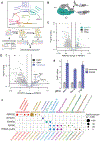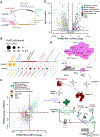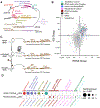CiBER-seq dissects genetic networks by quantitative CRISPRi profiling of expression phenotypes
- PMID: 33303588
- PMCID: PMC7819735
- DOI: 10.1126/science.abb9662
CiBER-seq dissects genetic networks by quantitative CRISPRi profiling of expression phenotypes
Abstract
To realize the promise of CRISPR-Cas9-based genetics, approaches are needed to quantify a specific, molecular phenotype across genome-wide libraries of genetic perturbations. We addressed this challenge by profiling transcriptional, translational, and posttranslational reporters using CRISPR interference (CRISPRi) with barcoded expression reporter sequencing (CiBER-seq). Our barcoding approach allowed us to connect an entire library of guides to their individual phenotypic consequences using pooled sequencing. CiBER-seq profiling fully recapitulated the integrated stress response (ISR) pathway in yeast. Genetic perturbations causing uncharged transfer RNA (tRNA) accumulation activated ISR reporter transcription. Notably, tRNA insufficiency also activated the reporter, independent of the uncharged tRNA sensor. By uncovering alternate triggers for ISR activation, we illustrate how precise, comprehensive CiBER-seq profiling provides a powerful and broadly applicable tool for dissecting genetic networks.
Copyright © 2020 The Authors, some rights reserved; exclusive licensee American Association for the Advancement of Science. No claim to original U.S. Government Works.
Conflict of interest statement
Figures






References
Publication types
MeSH terms
Substances
Grants and funding
LinkOut - more resources
Full Text Sources
Other Literature Sources
Molecular Biology Databases
Research Materials

